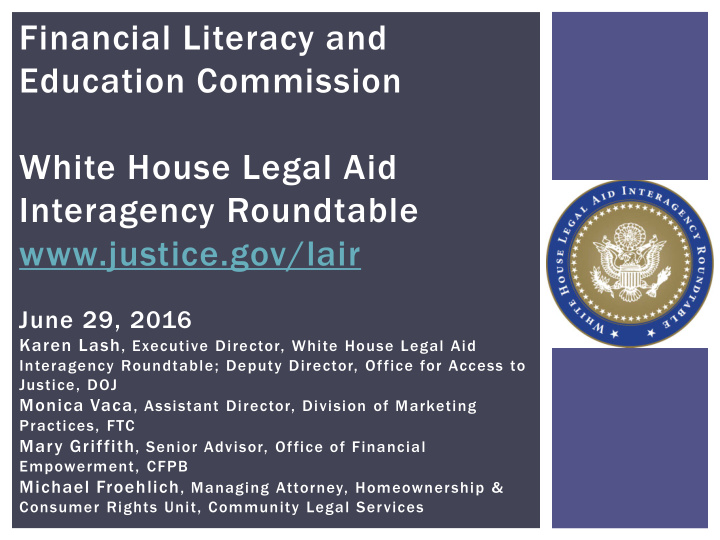



Financial Literacy and Education Commission White House Legal Aid Interagency Roundtable www.justice.gov/lair June 29, 2016 Karen Lash , Executive Director, White House Legal Aid Interagency Roundtable; Deputy Director, Office for Access to Justice, DOJ Monica Vaca , Assistant Director, Division of Marketing Practices, FTC Mary Griffith , Senior Advisor, Office of Financial Empowerment, CFPB Michael Froehlich , Managing Attorney, Homeownership & Consumer Rights Unit, Community Legal Services
LEGAL AID INTERAGENCY ROUNDTABLE BACKGROUND Conceived of and staffed by DOJ Office for Access to Justice (DOJ ATJ) since 2012 Co-chaired by White House Domestic Policy Council & DOJ Originally 18 federal partners Big I g Idea ea: : Many of our federal priorities, programs and policies that help low- and moderate-income and other vulnerable populations are more effective when they include civil legal aid. How ow? Increase resources Increase collaboration Remove barriers Increase research 2
PRESIDENTIAL MEMORANDUM – ESTABLISHES WHITE HOUSE LAIR HTTPS://WWW.JUSTICE.GOV/LAIR Signed September 24, 2015 21 Agencies Section 4: (a)The LAIR shall work across executive departments, agencies, and offices to: (i) improve coordination among Federal programs that help the vulnerable and underserved, so that those programs are more efficient and produce better outcomes by including, where appropriate, legal services among the range of supportive services provided; 3
1. L . Low Publi lic A Awar aren enes ess o of Leg egal al Aid id Most low-income people – and the social service providers they work with – do not identify a wide-range of problems as having a possible legal solution 2. . Ec Economic B Ben enef efits o of Inves esting in in Leg egal A al Aid id By Reducing Evictions By Helping Children Leave Foster Care By Protecting More Quickly Patients’ Health Civil Legal Aid By Helping People By Reducing Produces Participate in Federal Domestic Violence Economic Safety-Net Programs Benefits 4
WHAT IS LEGAL AID? Legal Aid is free legal assistance to Civil legal matters are non-criminal low & moderate income people legal matters, and include all of the who have civil legal problems. problems on this slide. Healthcare –access to medical and Family Law – custody, support, mental health benefits. visitation, adoption, guardianship, and divorce. Government benefits – SCHIP, TANF, Individual Safety –domestic or SSI, SNAP, Home Energy Assistance, dating violence, stalking or other and Earned Income Tax Credit. harassment, elder abuse, and child abuse and neglect. Housing –unsafe housing conditions, discrimination, unlawful eviction, Education – accommodations for children with special needs, ensuring foreclosure, loss or denial of education rights of homeless and subsidized housing benefits, and access migrant children, and school to public utilities. discipline matters. Employment –fair hiring and firing Veterans’ Services – veterans’ and practices, proper payment for work disability benefits. performed, unemployment benefits, Consumer Protection – consumer reasonable accommodations for people fraud and scams, predatory lending, with disabilities, working conditions, unfair debt collection practices and credit problems. and help securing drivers and professional licenses. 5
WHAT ARE LEGAL AID SERVICES? • Direct Services • Full representation • “Brief services” and advice • Identifying and Addressing Systemic Issues • Helping to identify solutions to problems common to large numbers of people • Community Education and Outreach • Know Your Rights materials and Self-help assistance • Trainings and Clinics so individuals can better determine eligibility for benefits MOST LE LEGAL L AID P D PROVI VIDERS LE LEVE VERAGE ALL LL THESE SE SERVI VICES W WITH: “Pro B “P Bono no” v volunt nteers: Private firm attorneys and paralegals, and law students and law school pro bono programs; and Onlin line Technolo logi gies: Document assembly & legal information websites 6
TOOLKIT CASE STUDY: https://www.justice.gov/lair/wh-lair-case-studies 7
Recommend
More recommend